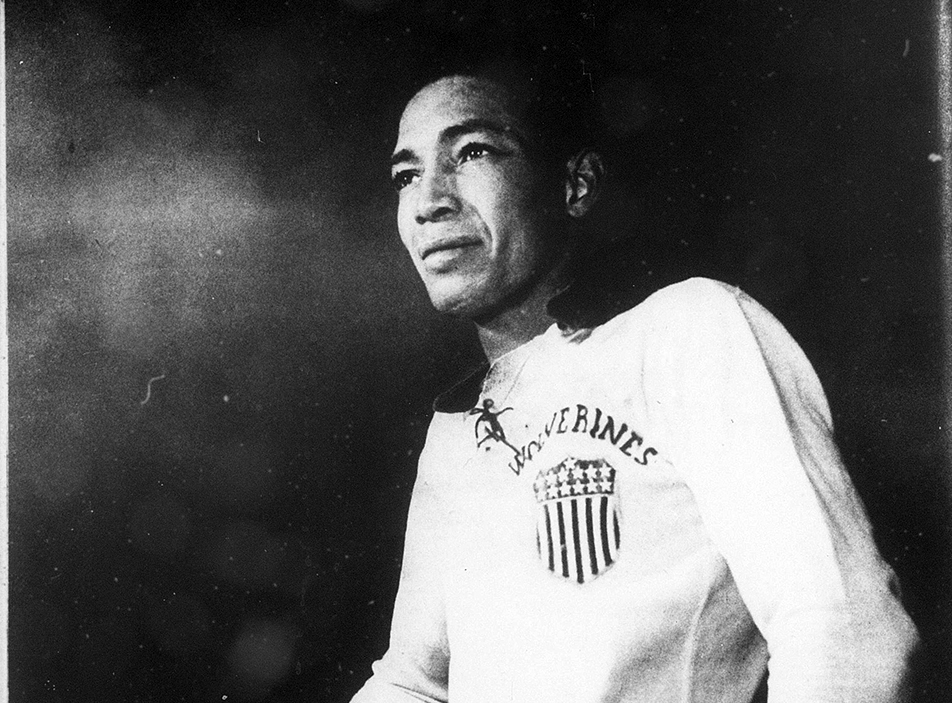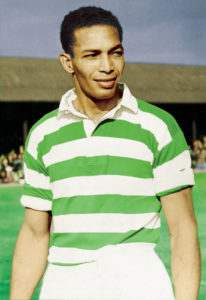
The list of important Black athletes from the era before sports became widely televised includes names such as Jack Johnson, the first African American to hold boxing’s heavyweight title; Jesse Owens, who won four gold medals at the 1936 Olympic games; and Wilma Rudolph, the winner of three gold medals in the 1960 summer games in Rome. As important as these figures are, their fame pales in comparison to that of Jackie Robinson. A talented athlete in many sports, Robinson made his name as the first African American to play professional baseball following the establishment of the sport’s infamous color line. In recent years his profile has only grown following the establishment of Major League Baseball’s Jackie Robinson Day in 2004 and the release of the film 42 in 2013.
But another man became the first Black professional soccer player in the United States almost a year before Robinson took the field with the Dodgers. His name was Gil Heron and he made his debut on June 7, 1946. [UPDATE: New research on the Watson brothers of Pawtucket, Rhode Island, has shown that Heron was probably not the first Black professional player in the United States]
Gilbert St. Elmo Heron was born in Jamaica on April 9, 1922. Like Robinson, he excelled in several sports as a child, including track and field and soccer. After his parents split up in 1938, he moved with his mother to the United States, settling in Cleveland where the family lived with an aunt. Once again, he showed himself a talented athlete. He lined up at running back for the Glenville High School Tarblooders football team while also boxing and playing baseball. Eventually, the family moved to Detroit. During WWII, Heron, who was still a British citizen because of his Jamaican birth, served with the Canadian Air Force. He spent most of his time in the military playing soccer and baseball.
After the war, Heron returned to Detroit and by 1945 was playing for the soccer club Venetia in the Detroit District Soccer League. His talent shone through as he scored an incredible 44 goals in just 14 games. A year later, a Chicago restaurant manager named Fred Weiszmann organized the North American Soccer Football League (NASFL) with squads in Chicago, Pittsburgh, Toronto, and Detroit. The idea of a pro soccer league was not new. The first two leagues in the US, and two of the earliest outside the United Kingdom, had formed in 1894. Although the American League of Professional Football and its rival the American Association of Professional Football folded after less than a year, big-league soccer experienced a resurgence when the American Soccer League (ASL) developed during the 1920s. The ASL featured a high level of competition and attracted talented international players, mostly from Northern and Central Europe. Although the original ASL collapsed following the Great Depression the competition eventually reformed as a mostly semi-professional organization. At first, the founder of the NASFL hoped to form a Midwestern section of the ASL but eventually decided to form a new league instead.

The 24-year-old Heron made his debut for the Detroit Wolverines on June 7, 1946, and quickly became one of the NASFL’s most exciting players. He scored a hat trick in the first league match played at Chicago’s Comiskey Park and went on to become the competition’s top scorer during its inaugural season. He also tallied a goal in the game that clinched the title for the Wolverines. Before the next season, Heron moved to the Chicago Maroons for what was reported to be “a substantial sum.” As a member of the Windy City team, he pocketed twenty-five dollars a game, the same salary he had earned the previous season in Detroit.
Although Heron is not well known today, the Black press at the time regularly celebrated his accomplishments. In a 1947 article Ebony magazine called him the “Babe Ruth of Soccer” and noted that he was the only Black professional soccer player in the country. The NASFL failed after just two seasons but Heron stayed on in Chicago where he married and had a son. He also continued to play soccer in the city, lining up for local powerhouses Sparta Athletic and Benevolent Association Football Club before returning to Detroit in 1950. Throughout his career, it seems that he did not routinely suffer the same level of racial hatred as Robinson faced while integrating baseball. Nevertheless, as the only Black professional in Chicago, he was often singled out for abuse by other players and fans. After matches, his wife helped rub down his legs with alcohol in order to soothe the muscles and heal marks left by opponents’ studs.
Eventually, Heron moved to Scotland and signed with one of the biggest clubs in global soccer, Celtic Football Club. For a variety of reasons he never really had much success in his two seasons with the Glasgow side but stayed in Britain for two more seasons while playing for Third Lanark and Kiderminster. After returning to Detroit in 1954, Heron faded into obscurity, his fame eventually eclipsed by that of his long-estranged son, the musician Gil Scott-Heron. For his talent as a player and his role as a pioneering professional Black athlete during a period of intense segregation, Heron deserves wider recognition.
Further reading: Leslie Gordon Goffe, Gil Scott-Heron. A Father and Son Story. Kingston: LMH Publishing, 2012.
Some speculation on what type of player he was and to see more images from the Ebony magazine profile click here.
A version of this post was first published at We’re History on June 8, 2016.

A true pioneer in an era of Jackie Robinson and other black ballplayers breaking the color barrier in Major League Baseball. Not surprising that Gil learned the game in the Caribbean, long a source of passion and players for the game in the USA.
Pingback: What Kind of Player was Gil Heron? – Society for American Soccer History
Pingback: The Barrow School Socker Foot Ball Team – Society for American Soccer History
Pingback: Gentlemen of Color: Oliver and Fred Watson, the earliest known African American soccer players in the United States – Society for American Soccer History